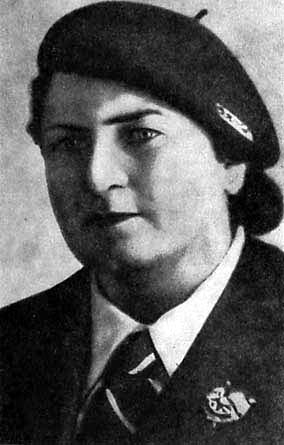Maria Fortus was born in 1900 in Kherson, Ukraine to the family of a rich Jewish banker and ship owner. In 1913 her father abandoned the family, and Maria and her sister Adelaida were forced to work. Maria worked as an embroiderer in a tailor's workshop and, at the same time, succeeded in passing the exams as an external student at the Kherson gymnasium for boys. In 1916, she joined the Socialist Revolutionary (SR) Party, but in 1917 left it for the Bolshevik (Communist) Party. She took part in the Russian civil war.
In 1919, during the French occupation of Black Sea ports, Fortus conducted Communist propaganda work among the French soldiers and sailors in Kherson. It was there that she met her first husband, Ramon Casanellas, then a young Spanish anarchist and, later, one of the heads of the Communist Party of Catalonia. After Casanellas' departure from Soviet Russia, in 1919, Fortus bore a son, whom named Ramon, after his father. During the civil war young Ramon was brought up by Maria's mother while Fortus continued her service with the Red Army as an intelligence worker. She was planted as a spy in the army of the Ukrainian anarchist Nestor Makhno. There her identity was discovered and she was sentenced to be shot but was saved by a miracle. After that, Fortus helped to uncover an anti-Soviet spy cell in Odessa. She was seriously wounded by a member of the cell, but survived. After the civil war, while studying in Moscow, by chance Maria encountered Ramon Casanellas, who, as a Communist who had fled Spain had came to Moscow to study at the same university. In 1929, the couple consisting of Ramon Casanellas and the supposedly "Uruguayan-born" Julia Jimenes (Maria Fortus' assumed name) came to Spain, where Maria worked as a Soviet intelligence agent. After the death of her husband in 1933, in 1934 Maria returned to Moscow. Upon her return, her son Ramon who was close to some Comintern members, expressed his desire to take part in the Spanish revolution. Maria's answer was "There have already been enough revolutionaries in our family".
However, in 1936, 16 year old Ramon Casanellas was sent to Spain to "work with Spanish youth" with his mother's consent. When, the civil war in Spain began four months after his departure, Fortus asked the Soviet leadership to be sent to Spain also: "My husband is buried there, and my son is there too", she argued. Formally, she was attached as an interpreter and an adjutant to a Soviet "military councilor" and future Marshall Kirill Meretskov. In fact, she served as a Soviet intelligence agent who on occasion also took part in combat. In 1937, while serving as a pilot in the Republican air force, her son was killed when his plane was shot down near Zaragoza.
While Maria Fortus was fighting in Spain, her brother Mikhail, a well known Orientalist and the founder of the first institute for Chinese studies in Moscow, was arrested by the Stalinist political police and then executed as an "enemy of the people."
In 1938, Maria Fortus returned to Moscow and entered the Frunze Military Academy. With the start of the Soviet-German war in 1941, she was appointed as chief of staff of the women's regiment commanded by the famous aviator Marina Raskova. However, Fortus was eager to return to intelligence activity and sent numerous requests in this regard to the military leadership. In 1942, a group of Spanish Republican émigrés was included into a diversion and intelligence unit acting in the enemy's rear, and Fortus, as a Spanish speaker, was included in this unit. In February 1943, after two Nazi top officers were captured by her unit in the vicinity of the city of Vinnitsa, Ukraine, Fortus obtained detailed information about the Wehrmacht HQ Werwolf, which had been constructed near this the city in 1942.
Fortus was wounded when she was with her partisan unit in 1943 and was then transported to the Soviet rear. After being released from hospital, she was assigned to the intelligence department of the 3rd Ukrainian Front. In January 1945, when the Soviet forces retreated from Székesfehérvár, Hungary, Fortus succeeded in planting a spy there, who succeeded in passing on much essential information to the Soviet command. This story served as the plot for the Hungarian feature film "Alba Regia" made by Mihály Szemes in 1961. Later Fortus infiltrated German-held Budapest and smuggled out secret documents that were held in the basement of the Royal Castle in Buda. In May-July 1945, after the war ended, she succeeded in finding two former Nazi underground factories – near Vienna and near the Czech town of Litoměřice.
Upon her return to the Soviet Union in 1945, Fortus continued her military service. In 1955 she retired with the rank of colonel. She wrote her memoirs and, in the late 1950s, defended a thesis in the field of sociology. She died in 1981.
Fortus's biography, especially her exploits in Spain during the civil war there, served as the plot for the Soviet feature film "Saliut, Mariia!" (1970). The film does not refer to its heroine's Jewish identity.

